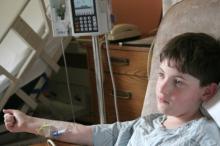Polypharmacy exposure is exceedingly common in hospitalized pediatric patients, particularly those with rare conditions, according to findings from a large retrospective cohort study involving nearly 600,000 children.
On their first day of hospitalization, children’s hospital patients younger than 1 year, for example, received a median of four distinct medications, and general hospital patients received a median of three. Among those at the 90th percentile of daily exposure to distinct medications, the median numbers were 11 and 8 for children’s hospital and general hospital patients, respectively, Dr. Chris Feudtner and his colleagues of the Children’s Hospital of Philadelphia reported online Sept. 5 in Archives of Pediatrics and Adolescent Medicine (2011 [doi:10.1001/archpediatrics.2011.161]).
Among those older than 1 year, the median number of medications received on day 1 of hospitalization was 5 for both children’s and general hospital patients, and among those at the 90th percentile of daily exposure to distinct medications, the median numbers were 13 and 12 for children’s and general hospital patients, respectively.
The median cumulative number of distinct generic drug and therapeutic agent exposures for each successive day of hospitalization for those under age 1 year increased from 4 on the first hospital day to 25 by day 30 (for those who remained hospitalized), and for those in the 90th percentile of median cumulative exposure the number increased from 11 on the first hospital day to 51 by hospital day 30. For those over age 1 year, the median cumulative exposure increased from 5 to 42 by day 30, and for those in the 90th percentile of median cumulative exposure, the number increased from 13 to 66 by day 30.
Although the types of exposures varied by age and hospital type, the most common exposures were to acetaminophen, albuterol, antibiotics, fentanyl, heparin, ibuprofen, morphine, ondansetron, propofol, and ranitidine. Higher rates of exposures were shown to be significantly more likely to occur in patients with rare conditions, regardless of hospital type, and the differences in the number of medications used by the hospitals were found to reflect the underlying differences in their patient populations, the investigators noted.
The findings are based on data from the Pediatric Health Information System and the Perspective Data Warehouse, including 587,427 patients hospitalized during 2006 at any of 411 general hospitals and 52 children’s hospitals across the United States. These hospitalizations represent about one-fifth of all pediatric hospitalizations in the United States.
A total of 365,868 patients experienced 491,451 hospitalizations in the children’s hospitals, and a total of 221,559 experienced 260,740 hospitalizations in the general hospitals. Patients were under age 18 years; healthy newborns were excluded.
Despite limitations of the study – such as lack of certainty about the accuracy of data and about whether patients actually received the prescribed medications, as well as lack of information on the indication for which the medications were prescribed – the findings offer at least three important means of improving pediatric inpatient medication efficacy, effectiveness, and safety, the investigators said. For example, the ranking of medications based on the prevalence of exposures can guide prioritization of further research.
"Second, the level of polypharmacy exposure found in this study raises patient safety concerns, given the relationship between polypharmacy and adverse drug events that has been documented for adults in both hospital and nursing home settings," the authors noted. They added that "the common exposure to polypharmacy among hospitalized children motivates investigation of combinations of drugs and therapeutic agents to which patients are exposed and studies to detect potentially adverse drug-drug interactions, especially for patients in intensive care unit settings and patients with complex chronic conditions, who are at higher risk of polypharmacy."
Also, the databases used for the study "offer the potential to conduct rigorous comparative effectiveness and safety studies," they said.
The study authors had no disclosures to report.


